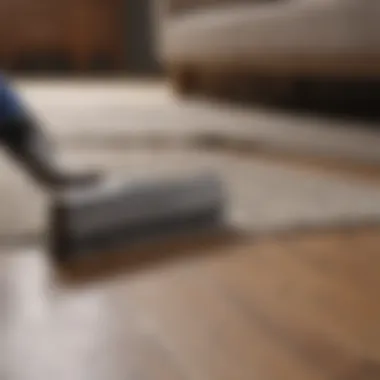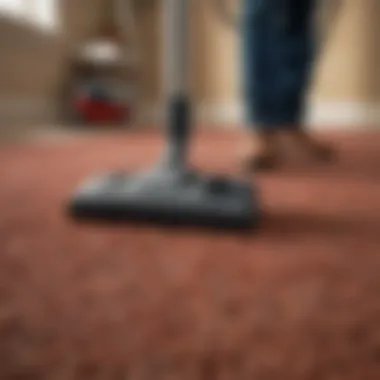Comprehensive Guide: How to Clean Area Carpets Effectively


Intro
Keeping area carpets clean is not just a matter of aesthetics; it is essential for maintaining a healthy living environment. Many homeowners might overlook the significance of routine carpet upkeep, but in reality, proper cleaning methods can enhance the material's lifespan and preserve its beauty. This guide aims to explore various effective techniques for cleaning area carpets, emphasizing preparation steps, appropriate cleaning solutions, and overall maintenance strategies.
Understanding the unique properties of different carpet materials is vital for choosing the right cleaning method. Additionally, recognizing the importance of stain prevention will help maintain the carpet's integrity over time. This guide is tailored for homeowners and design enthusiasts seeking to elevate their space while ensuring their carpets remain in optimal condition. By following these tips, anyone can keep their area carpets looking new for years to come.
Understanding Area Carpets
Understanding area carpets is crucial for anyone who wants to maintain the aesthetic and functional qualities of their flooring. This knowledge sets the stage for effective cleaning and maintenance practices. An area carpet can significantly influence the overall atmosphere of a room. Therefore, knowing its characteristics and how it interacts with the surrounding environment is essential.
Definition and Characteristics
Area carpets are defined as floor coverings designed to cover a specific area of a room rather than the entire floor. These are typically smaller than wall-to-wall carpeting but larger than a simple rug. They serve both practical and decorative functions, adding warmth and comfort to living spaces. Key characteristics include durability, design versatility, and a range of patterns and colors that can complement various interior styles.
Common Materials Used
Wool
Wool is a natural fiber that has been prized for centuries for its luxurious feel and durability. Its resilience makes it a popular choice for area carpets. Wool fibers have natural elasticity, allowing them to retain their shape and appearance over time. Additionally, wool is effective at regulating temperature and absorbing moisture, which can enhance indoor comfort. However, it can be susceptible to stains and may require more specialized cleaning methods.
Nylon
Nylon is a synthetic fiber widely used in carpets for its strength and resistance to wear. This material has a high resilience to crushing and matting, making it a good choice for high-traffic areas. Nylon carpets usually come in vibrant colors and can be treated with stain-repellent chemicals. Although it can be more affordable than wool, nylon isn’t as environmentally friendly, and its production involves the use of chemicals.
Polyester
Polyester carpets offer a soft feel and vibrant color options, thanks to their dye absorption capabilities. This synthetic fiber is more resistant to fading compared to other materials. They are also less expensive than wool or nylon, making polyester carpets an appealing option for budget-conscious consumers. However, polyester’s durability can be a concern in high-traffic areas, as it may not withstand heavy use as well.
Natural Fibers
Natural fibers include materials like jute, sisal, and seagrass. These fibers offer a unique texture and a sustainable option for environmentally conscious homeowners. Natural fiber carpets have a rustic charm and are often used in casual, eco-friendly settings. However, they can be less durable and may not handle spills well, giving way to stains and wear more quickly than other materials.
Importance of Cleaning Area Carpets
Cleaning area carpets is not just about maintaining their appearance; it is a fundamental aspect of home care that impacts many elements of interior design, health, and overall aesthetics. Regular cleaning ensures that these textiles continue to be a source of comfort and style rather than a hub for dirt and allergens. Here, we explore the significant reasons that underscore the importance of cleaning area carpets.
Aesthetic Appeal
The visual aspect of area carpets cannot be overstated. These carpets often serve as focal points within a room, influencing the overall ambience of the space. Clean carpets reflect light differently, enhancing colors and patterns, which makes the room more inviting. When carpets are neglected, they can exhibit stains, dirt, and wear patches. A dirty carpet detracts from the beauty of your home. Regular cleaning restores vibrancy and depth to the colors, allowing the design to shine through. Homeowners aiming for a cohesive and elegant look must prioritize carpet care to maintain a welcoming atmosphere.
Health Considerations
There are important health implications associated with dirty carpets. Area carpets can harbor allergens such as dust mites, pet dander, mold spores, and pollen. These allergens can trigger respiratory illnesses and exacerbate asthma or allergies. Regular carpet cleaning helps to remove these particles, promoting a healthier indoor environment.
"Regular cleaning of area carpets is essential for a healthy living space, reducing the risk of respiratory diseases and allergies throughout your home."
Furthermore, dirty carpets can also become breeding grounds for bacteria. Keeping them clean not only safeguards physical health but also enhances mental well-being by providing a clean setting free from pollutants. For families with young children or pets, the stakes are even higher, making regular cleaning a necessity rather than a luxury.
Preservation of Material Integrity
Every material has its lifespan, and carpets are no different. Proper cleaning techniques help preserve the integrity of the carpet fibers. Many types of area carpets—such as those made from wool, nylon, or polyester—are sensitive to dirt and stains. Accumulated dirt can embed into the fibers and lead to premature wear and tear. This results in loss of texture and can alter the appearance of the carpet significantly.
To extend the lifespan of area carpets, adhere to a consistent cleaning schedule. With appropriate cleaning methods, carpets can maintain their strength and look over time. Neglect can result in damage that is costly to repair or replace. Thus, regular cleaning is not just about appearance; it is an investment in the durability and longevity of your carpets.
Preparing for the Cleaning Process
Preparing for the cleaning process is a critical step in ensuring that area carpets are maintained effectively. It encompasses assessing the carpet's condition and gathering the necessary tools and supplies. These actions lay a solid foundation for successful cleaning and help in preventing any potential damage during the process. Being well-prepared not only enhances the efficiency of cleaning but also protects the aesthetic and functional qualities of the carpet.


Assessing the Carpet Condition
Before beginning the cleaning process, it is essential to evaluate the overall state of the carpet. This involves checking for any stains, tears, or signs of wear. Look closely for dirt buildup or matted fibers. If the carpet has visible stains, it is vital to identify the source as it may require specialized cleaning methods. A thorough assessment helps in determining the appropriate cleaning technique and products. Ignoring this step may not only prolong the cleaning process, but it can also lead to improper treatment, worsening existing damage.
Gathering Necessary Tools and Supplies
Choosing the right tools and supplies is vital for effective carpet cleaning. Having the correct items ready can streamline the cleaning process and improve results. Below is a closer look at specific supplies that will facilitate the cleaning process.
Vacuum Cleaner
A vacuum cleaner is one of the most important tools for carpet cleaning. It helps remove loose dirt and debris before any wet cleaning begins. A good vacuum should have strong suction power, adjustable height settings, and durable brush rolls. These features allow it to clean various carpet types effectively. Additionally, a vacuum cleaner with a HEPA filter can be beneficial for reducing allergens in the home. However, it is essential to note that traditional vacuum cleaners might not remove all deeply embedded stains, making other cleaning methods necessary.
Cleaning Solutions
Cleaning solutions play a significant role in preserving the integrity of the carpet materials. Choosing the right cleaning solution especially formulated for specific carpet types is very crucial. Many cleaning agents are designed to address particular stains, such as pet accidents or food spills. Some solutions are eco-friendly, which aligns with a growing awareness of environmental impact. However, one should be cautious, as strong chemicals can cause damage to certain fibers. Always read labels and ensure compatibility with your carpet's material.
Soft Brushes
Soft brushes are essential for gently agitating the carpet fibers during cleaning. They help in lifting dirt and debris without causing damage. A brush with soft bristles is suitable for delicate carpets, while stiffer brushes may be needed for more durable materials. The main advantage of using a soft brush is that it ensures greater thoroughness in the cleaning process without risk of fraying the fibers. Nonetheless, care must be taken not to over-scrub as this can lead to wear over time.
Microfiber Cloths
Microfiber cloths are an excellent tool for post-cleaning touch-ups. Their absorbent nature makes them perfect for soaking up extra moisture and cleaning up leftover residue. They can be used in conjunction with cleaning solutions for detail work on stains or high-traffic areas. One key advantage of microfiber cloths is that they can be reused multiple times, making them cost-effective and eco-friendly. Using them in different cleaning scenarios can yield much better results, but they must be washed regularly to maintain their effectiveness.
It is crucial to have these tools and supplies on hand before embarking on the cleaning project. Adequate preparation will lead to a more effective cleaning session, enhancing the lifespan and appearance of your area carpets.
Cleaning Techniques
When it comes to maintaining area carpets, understanding the various cleaning techniques is vital. Each method offers unique advantages and considerations. Choosing the right approach can enhance the appearance and longevity of your carpets. It also plays a significant role in preserving indoor air quality and preventing the accumulation of allergens. This section will delve into the three primary cleaning methods: dry cleaning, wet cleaning, and spot cleaning techniques.
Dry Cleaning Method
Advantages and Disadvantages
The dry cleaning method uses chemicals to clean carpets without the need for water. This offers several benefits. It's a fast process, allowing carpets to dry quickly, which makes it beneficial in high-traffic areas. The primary active ingredients, often in powder form, attract dirt and stains. However, there are downsides. Some may find that dry cleaning does not remove deep stains effectively. Additionally, overuse of chemical cleaners could harm delicate fibers.
Step-by-Step Process
Performing a dry cleaning can be methodical. First, vacuum the carpet to remove loose dirt. Then, sprinkle the dry cleaning powder evenly across the surface. Next, brush the powder into the carpet fibers using a soft-bristle brush. Allow it to sit for the recommended time, usually 10 to 30 minutes. Finally, vacuum to remove the powder and any attracted dirt. This method offers a simple and effective approach for regular maintenance.
Wet Cleaning Method
Types of Wet Cleaning Solutions
Wet cleaning methods utilize liquid solutions to clean carpets. These consist of steam cleaning and shampooing. Steam cleaning uses hot water mixed with cleaning agents. It’s effective in deep cleaning and often recommended for heavily soiled carpets. In contrast, carpet shampooers use foam solutions that are agitated into the fibers. The chosen solution will depend on the carpet's material and the level of soil. Both options are popular for their thoroughness but require more time for drying afterward.
Detailed Cleaning Procedure
Carpet wet cleaning needs careful execution. First, check the carpet’s cleaning instructions for compatibility. Then, prepare the cleaning solution according to package instructions. Using a steam cleaner, apply the solution to one section at a time. Move slowly to allow the solution to penetrate. After treatment, extract as much water as possible. Regularly checking the water tank during the process helps prevent over-saturation. Finally, air drying can be sped up by using fans or opening windows.
Spot Cleaning Techniques
Identifying Different Stains
Spot cleaning is crucial for treating specific stains. Recognizing the type of stain helps in selecting the appropriate solution. Common stains include food, drink, mud, and pet accidents. Organic stains may require enzymatic cleaners, while synthetic stains often respond well to solvents. Understanding these differences is key to effective treatment. Spot cleaning aims to minimize stain appearance while maintaining carpet integrity.
Targeted Cleaning Solutions
Using targeted solutions can significantly improve stain removal success. It's important to apply the solution directly on the stain and gently blot. Avoid scrubbing, as it can damage fibers. After application, allow it to sit for the recommended time and then blot with a clean cloth. This technique focuses on spot treatments without needing full carpet cleaning. It’s a practical choice for everyday maintenance.


"Regular cleaning and prompt stain treatment are crucial for preserving both the beauty and lifespan of area carpets."
Post-Cleaning Care
Post-cleaning care is a critical component of maintaining the aesthetic and functional qualities of area carpets. This stage is essential for ensuring that the efforts you put into cleaning do not go to waste. Proper care after cleaning contributes to carpet longevity, helps in the prevention of future damage, and reinforces the cleanliness achieved through the cleaning techniques employed. It is not simply about how well a carpet is cleaned, but also about how it is treated afterward.
Drying Techniques
The drying process can significantly affect the carpet's health and appearance. Proper techniques help to prevent the growth of mold and mildew, which can thrive in damp conditions. Here are some recommended drying techniques:
- Air Drying: This is the most common method and involves simply allowing the carpet to dry naturally. Ensure good air circulation to speed up the process. Opening windows or using fans can assist in creating an optimal drying environment.
- Dehumidifiers: Using a dehumidifier can extract moisture from the air, reducing drying time. This is especially useful in humid climates and can prevent potential damage caused by prolonged dampness.
- Heat Sources: Gentle application of heat can help with drying. However, it is important not to use excessive heat as this could damage the fibers.
Regular Maintenance Tips
Regular maintenance is vital for upkeep and extends the life of area carpets. Here are some critical tips for maintaining your carpets effectively:
Vacuuming Schedules
Establishing a regular vacuuming schedule is essential for keeping your area carpets in optimal condition. Regular vacuuming helps to remove dirt and allergens, preventing them from settling deep into the fibers. Here are key points about vacuuming schedules:
- Frequency: Aim to vacuum high-traffic areas at least two to three times a week. Lesser-used areas can be vacuumed weekly.
- Equipment Choice: Use a vacuum cleaner that is specifically designed for the type of carpet you have. This ensures effective cleaning without causing damage.
The unique characteristic of a planned vacuuming schedule is its ability to prevent dirt buildup, which makes deep cleaning easier and less frequent.
Preventive Measures Against Stains
Preventing stains is always better than dealing with them later. Implementing proactive measures can save significant time and effort in carpet care. Here are some tips:
- Rugs and Mats: Place area rugs or mats in strategic locations, especially at entry points, to capture dirt before it touches the carpet.
- Stain Resistant Treatments: Consider applying stain-resistant treatments after cleaning. These coatings provide an extra layer of protection against spills and dirt.
The main advantage of taking preventive measures is the reduction of potential staining incidents, leading to less frequent deep cleaning. This not only helps maintain the carpet's appearance but also enhances its durability.
Remember: Keeping a carpet clean requires ongoing effort. Regular maintenance, including proper drying and preventive measures, is key to ensuring that carpets retain their beauty and functionality over time.
When to Call Professionals
Cleaning area carpets can be a straightforward task for many homeowners. However, there are certain instances where professional help becomes essential. Understanding when to enlist the services of experts is crucial to maintain your carpets' appearance and longevity. Professionals bring a unique set of skills and tools that can address issues beyond standard cleaning capabilities.
Signs of Significant Damage
Some carpets may exhibit signs of wear or damage that are not easily repaired through regular cleaning. Key indicators include:
- Persistent Stains: If a stain remains despite multiple cleaning attempts, it may need professional treatment.
- Fading or Discoloration: Areas of your carpet that look completely different from the rest might have underlying damage.
- Fraying Edges: Loose fibers or edges may indicate that the carpet is on the verge of unraveling.
- Odors: A persistent bad smell, particularly if it seems to be coming from the carpet, often suggests deeper issues, like mold or mildew, that need expert cleaning.
- Water Damage: If your carpet was exposed to water or flooding, you should not wait too long to call professional services to prevent lasting damage.
When identifying these signs, it is vital to act quickly. Ignoring them can lead to further deterioration of the carpet, resulting in expensive replacements.
Benefits of Professional Cleaning Services
Engaging professional cleaning services comes with multiple advantages. For instance, these services often use advanced techniques and equipment, providing a deeper clean than most DIY methods can achieve. Here are some benefits:
- Expert Evaluation: Professionals assess the condition of your carpet and recommend appropriate cleaning strategies.
- Specialized Equipment: Industrial-grade tools can effectively remove dirt, allergens, and stains that regular home-use vacuums cannot.
- Time Saving: Cleaning carpets, especially those with significant damage, can be time-consuming. Professionals save you valuable time.
- Preventative Strategies: Professionals not only clean but also offer advice on future maintenance to avoid damage and stains.
- Health Benefits: Deep cleaning removes dust mites, mold spores, and allergens, improving the air quality in your home.
In summary, knowing when to call professionals is critical in preserving your area carpets. It is wise to consult experts when significant damage is visible or when health risks are present, so your space remains safe and visually appealing.
Eco-Friendly Cleaning Options
Importance of Eco-Friendly Cleaning


Eco-friendly cleaning methods are crucial in modern carpet care. Traditional cleaning products often contain harsh chemicals. These substances can cause harm to the environment and affect indoor air quality. Adopting sustainable cleaning practices reduces your ecological footprint. Using eco-friendly options contributes to safer homes, particularly for children and pets. Furthermore, it aligns with a growing trend among consumers towards sustainability. Many homeowners are increasingly aware of the health implications associatd with chemical exposure. These factors position eco-friendly cleaning as not just a choice, but a responsible action in today’s world.
Homemade Cleaning Solutions
Homemade cleaning solutions are effective alternatives to commercial products. They are often cheaper and safer for the environment. Below are three common household ingredients that can be valuable in cleaning area carpets:
Baking Soda
Baking soda stands out as a versatile cleaner. It excels at eliminating odors. Its alkaline nature allows it to break down stains effectively. When used on carpets, a sprinkle on the affected area can neutralize unpleasant smells. Additionally, it is non-toxic, which makes it a popular choice among families.
Key Characteristics:
- Non-toxic and safe for pets.
- Effective at odor removal.
Unique Features and Considerations:
Baking soda's main advantage is its safety and effectiveness. However, it requires thorough vacuuming after application, ensuring no residue remains.
White Vinegar
White vinegar is another powerful cleaning agent. It possesses natural disinfecting properties. This feature makes it suitable for stain removal on carpets. When diluted with water, it becomes a gentle cleanser.
Key Characteristics:
- Natural disinfectant and stain remover.
- Works well in combination with water.
Unique Features and Considerations:
While white vinegar is highly effective, it may leave a strong scent initially, which dissipates as it dries. Care is needed to avoid overuse, as repeated application can weaken some carpet materials.
Lemon Juice
Lemon juice is praised for its natural acidity and refreshing scent. It can effectively tackle stains, especially those caused by organic matter. Lemon is often used in homemade cleaning recipes due to its pleasant aroma and antibacterial properties.
Key Characteristics:
- Natural stain remover with a pleasant fragrance.
- Contains acid that can cut through grease and grime.
Unique Features and Considerations:
Caution is necessary with lemon juice use. Its acidity can potentially damage sensitive carpet fibers if used excessively. However, when combined with water, it can be very effective without causing harm.
Final Note: Using eco-friendly solutions does not compromise cleaning efficiency. By opting for these natural alternatives, one can achieve cleanliness while endorsing health and environmental sustainability.
End
In this article, we have navigated the complexities of maintaining area carpets through effective cleaning techniques. The importance of cleaning area carpets cannot be overstated. Not only do they enhance the aesthetic of any space, but they also play a crucial role in promoting a healthier indoor environment. Regular cleaning prevents dirt accumulation, which can lead to wear and tear as well as health issues due to trapped allergens.
Recap of Cleaning Essentials
To conclude, effective carpet cleaning requires a clear understanding of the right practices and tools. Here is a brief recap of the essentials:
- Assessing Carpet Condition: Before you begin, always evaluate the state of your carpet. Look for stains, wear, or damage.
- Gathering Tools: Ensure you have all necessary cleaning supplies such as a vacuum cleaner, suitable cleaning solutions, soft brushes, and microfiber cloths.
- Choosing Techniques: Decide between dry cleaning, wet cleaning, or spot cleaning based on the type of stain and the carpet material.
- Post-Cleaning Care: Implement proper drying techniques and regular maintenance routines to prolong the life of your carpets.
Each of these steps contributes significantly to the overall effectiveness of your cleaning efforts. Keeping your area carpets clean requires attention to detail and consistency.
Final Thoughts on Carpet Care
In final thoughts, the care of area carpets extends beyond mere aesthetics. Understanding the unique materials and associated cleaning techniques will empower you to make informed decisions. The preservation of carpet integrity is vital. This not only maintains its appearance but also ensures it lasts longer in your living spaces.
Invest in eco-friendly solutions when possible. Homemade cleaning options not only provide effective solutions but also reduce chemical exposure for you and your family. Remember, regular maintenance is key. Set up a vacuuming routine and act swiftly on spills to maintain your carpet's beauty.
"A clean carpet not only enhances the decor of your home but also contributes to a healthier living environment."
With the knowledge acquired from this guide, you are now equipped to tackle your area carpets with confidence. Maintain attention to detail and you will see the results in the longevity and aesthetic appeal of your carpets.







